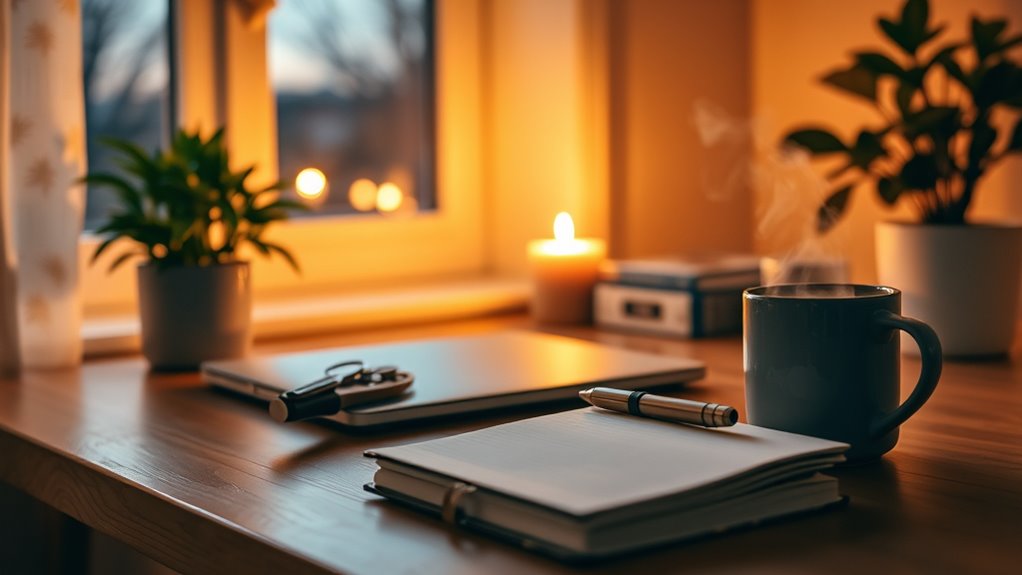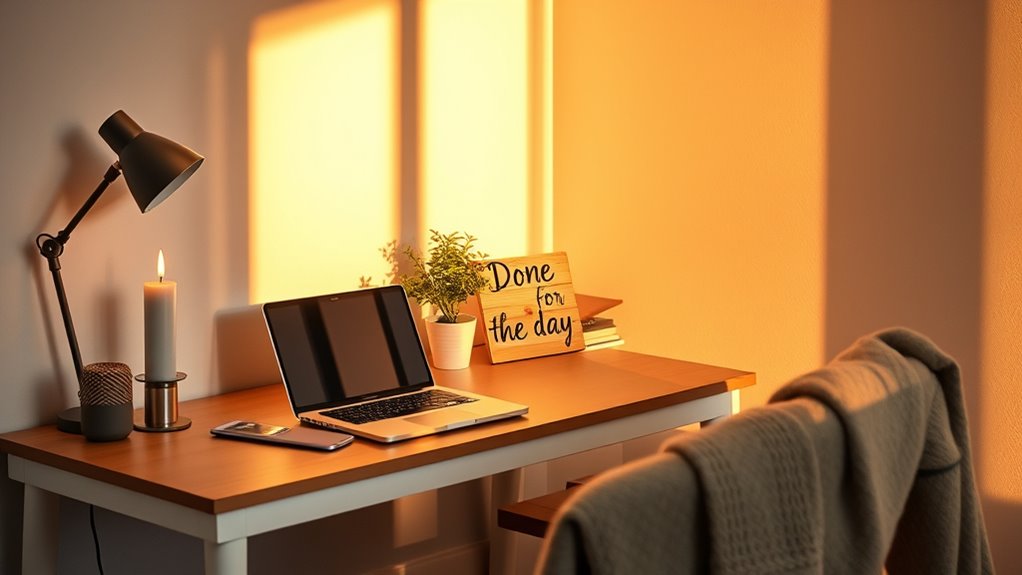To design a effective “done for the day” ritual, watch for signs like feeling overwhelmed or distracted, and use clear cues such as shutting down your computer or saying a closing phrase. Incorporate mindfulness through breathing, visualization, or journaling, and set boundaries by turning off notifications and creating tech-free zones. Personalize your routine with calming activities, and stick to it consistently. Keep exploring tips to craft a ritual that truly protects your evenings and helps you unwind.
Key Takeaways
- Establish a consistent physical cue, like shutting down your computer or turning off work notifications, to signal the end of work.
- Incorporate calming activities such as mindful breathing, aromatherapy, or gentle stretching to transition into relaxation.
- Create a dedicated space or ritual, like journaling or tidying your workspace, to reinforce boundaries between work and personal time.
- Set clear digital boundaries by turning off work emails and notifications at a specific time each evening.
- Personalize your routine with elements like calming music or a favorite beverage to make the transition enjoyable and sustainable.
Recognizing the Signs That Signal the End of Work

Recognizing when it’s time to stop working is key to maintaining a healthy work-life balance. Pay attention to signs that indicate your tasks are complete or that your focus is waning. When you start feeling overwhelmed, distracted, or physically tired, it’s a signal to wrap up. Notice if your productivity drops or if you’re repeatedly revisiting the same issues without progress. These cues suggest it’s time to pause, preventing burnout and reducing stress. Establishing awareness of these signals helps you create boundaries, so work doesn’t spill into personal time. By tuning into your mental and physical state, you can better manage your workload and enjoy your evenings, ultimately supporting your stress reduction and overall well-being. Being aware of your work hours and retail hours today list can help you plan your evening routines effectively. Recognizing these signs keeps your work and personal life balanced.
Creating a Transition Routine to Mark Closure

You need clear signals to mark the end of your workday, so choose consistent cues like shutting down your computer or tidying your workspace. Incorporate mindful activities such as deep breathing or stretching to help you shift mentally and physically. These routines create a clear boundary, helping you leave work behind and relax fully.
Establish Clear Signals
Establishing clear signals is essential for creating an effective shiftover routine that marks the end of your workday. These signals help you switch from work mode to personal time, supporting your work-life balance and reducing stress. To make this transition smooth, consider these three strategies:
- Use a specific physical cue, like shutting down your computer or turning off a work-related device.
- Create a visual indicator, such as closing a calendar or filing away documents.
- Develop a verbal cue, like saying, “Done for the day,” to signal closure.
- Incorporating local tips or personal rituals can further reinforce your transition routine, making it more effective and enjoyable.
These signals reinforce boundaries, making it easier to disconnect and enjoy your evenings without work lingering. Clear signals create consistency, making it easier to leave work behind and protect your personal time.
Incorporate Mindful Activities
After setting clear signals to mark the end of your workday, adding mindful activities can deepen that moment of closure. Engage in mindful breathing to help you shift focus from work to relaxation. Take slow, deep breaths, paying close attention to each inhale and exhale. Incorporate calming visualization by imagining a peaceful scene, like a quiet beach or a serene forest. These practices ground you in the present, reducing stress and mental clutter. By consciously pausing to breathe and visualize, you create a meaningful changeover from work mode to personal time. This intentional step signals to your mind that the day’s responsibilities are complete, making it easier to fully disconnect and enjoy your evening. Additionally, consider home security systems to ensure your space feels safe and secure once you transition into personal time.
Incorporating Mindfulness and Reflection Practices

Adding mindfulness and reflection practices helps you shift smoothly from work to rest. You can try mindful breathing, journaling your thoughts, or listing what you’re grateful for in the evening. These simple steps deepen your awareness and bring closure to your day. Incorporating techniques like color calibration can further enhance your evening routine by improving your overall well-being.
Mindful Transition Techniques
To smoothly shift from work to personal time, incorporating mindfulness and reflection practices can make a significant difference. These techniques help you disconnect and reset your mind. Consider these mindful transition methods:
- Take a brief nature walk, focusing on your surroundings, sounds, and smells to ground yourself in the present.
- Engage in aromatherapy sessions, inhaling calming scents like lavender or chamomile to relax your mind.
- Practice a quick body scan meditation, paying attention to physical sensations and releasing tension.
- Incorporate empathy-based self-awareness practices to acknowledge your feelings and set gentle intentions for your personal time.
These practices foster awareness, ease mental clutter, and create a clear boundary between work and personal life. By intentionally shifting your focus, you’ll enter your evening with a calmer, more centered mindset.
Reflective Journaling Moments
Reflective journaling moments offer a powerful way to process your day and cultivate mindfulness. By taking time to write about your experiences, you reinforce workday boundaries and create a clear mental separation between work and personal life. Use your journal to reflect on what went well and identify areas for improvement, helping you gain perspective. Incorporate relaxation techniques as you write, such as deep breathing or gentle stretching, to deepen your sense of calm. This practice encourages intentional reflection, making it easier to let go of work-related stress. Over time, journaling becomes a mindful ritual that signals the end of your workday, fostering a peaceful progression into your evening and supporting overall well-being. Additionally, establishing mental boundaries through such rituals can help prevent burnout and promote sustained focus.
Evening Gratitude Practices
In the quiet moments at the end of your day, practicing gratitude can help you shift focus from stress to appreciation. Incorporating evening gratitude practices into your nightly routine enhances your work-life balance and strengthens your evening rituals. To make this effective, try these three approaches:
- Write down three things you’re grateful for, focusing on positive moments from your day.
- Take a few mindful breaths, reflecting on the people or experiences that brought you joy.
- Share your gratitude with a partner or journal, reinforcing a sense of connection and contentment.
- Visualize a protective light surrounding your aura to maintain energetic boundaries and promote spiritual cleanliness during your reflection.
These simple steps help you wind down intentionally, fostering a positive mindset, and protecting your evenings from work-related stress. Regular gratitude practices cultivate a peaceful *passage* from work to personal life.
Setting Boundaries With Technology and Communication

Establishing clear boundaries with technology and communication is essential for creating a true end to your workday. A digital detox signals to your brain that it’s time to unwind, so consider designating tech-free zones in your home, like the bedroom or dining area. Turn off work notifications and set specific times to check emails or messages, preventing work from spilling into your evening. Communicate these boundaries to colleagues and family to ensure they respect your designated downtime. Limiting screen time helps reduce mental clutter and fosters a sense of separation between work and personal life. Being mindful of cookie preferences can also support your digital boundaries by controlling the types of online activities you engage in. By intentionally creating these boundaries, you give yourself space to relax, recharge, and enjoy your evening without the constant pull of digital distractions.
Personalizing Rituals to Fit Your Lifestyle

Once you’ve set boundaries with technology, tailoring your “done for the day” ritual to suit your lifestyle makes it more effective and enjoyable. Your work environment and personal preferences play a key role in shaping this routine. Consider these options:
- Incorporate a short walk or stretching to shift from work to personal time.
- Use calming music or a specific scent that relaxes you, aligning with your preferences.
- Create a dedicated space or activity that signals the end of your workday, whether it’s journaling or tidying your workspace.
Maintaining Consistency for Lasting Impact

To guarantee your “done for the day” ritual has a lasting impact, consistency is key. Sticking to the same evening routines helps reinforce boundaries between work and personal life, improving your work-life balance. When you perform your ritual regularly, it signals to your brain that it’s time to unwind, making the shift smoother. To stay on track, consider these factors: Elevate Your Home With the Art of Italian Espresso.
Frequently Asked Questions
How Can I Adjust My Ritual During Unpredictable Work Hours?
When your work hours are unpredictable, you can still maintain your evening boundaries by embracing flexible scheduling and adaptable routines. You might set a general plan, like a wind-down time, but stay open to shifting it if needed. Use cues like a specific signal to start your ritual, regardless of when work ends. This flexibility helps you protect your evenings while accommodating changing work demands.
What Are Common Pitfalls When Establishing a “Done for the Day” Routine?
When establishing a “done for the day” routine, you might face common pitfalls like neglecting workload management and consistency challenges. You may find it hard to stick to a set time or routine, especially if work spills over or deadlines shift. To avoid this, set clear boundaries, prioritize tasks, and stick to your schedule. Consistency is key, so remind yourself of the importance of protecting your evenings for rest and personal time.
How Do I Involve Family or Colleagues in My Evening Ritual?
Imagine you’re wrapping up your day, and suddenly, family involvement or colleague participation makes the shift smoother. You can invite your family to share a closing activity or set a shared signal with colleagues, like a quick check-in. This fosters connection and commitment, making your routine more effective. By involving others, you create a supportive environment that respects your boundaries and helps everyone unwind together, strengthening relationships and setting clear boundaries.
Can a Digital Detox Be Integrated Into This Transition Routine?
You can definitely integrate a digital detox into your change routine. Start by setting a specific time to power down screens, creating a screen-free shift period. Use this time to unwind, reflect, or do a calming activity. This digital detox helps you disconnect from work or social media, making your evening ritual more effective. It signals to your mind that the workday is done, protecting your evenings and promoting relaxation.
What Signs Indicate My Ritual Is Effectively Helping Me Disconnect?
Research suggests effective routines improve work-life balance and reduce stress. You’ll notice your ritual is working when you feel a clear mental shift from work to relaxation, with decreased anxiety and fewer lingering thoughts about work tasks. You might also experience a sense of calm, more present during evenings, and improved sleep. These signs indicate your ritual helps you disconnect, fostering healthier boundaries and promoting overall stress reduction.
Conclusion
By establishing a clear “done for the day” ritual, you create a boundary that protects your evenings. It’s a simple act, yet it can feel like a liberation from endless tasks and notifications. As you step away from work, you reclaim your time—no longer just a worker, but a person with space to breathe, reflect, and reconnect. In this shift from obligation to ownership, you find the true peace that comes with knowing your evenings are truly yours.









